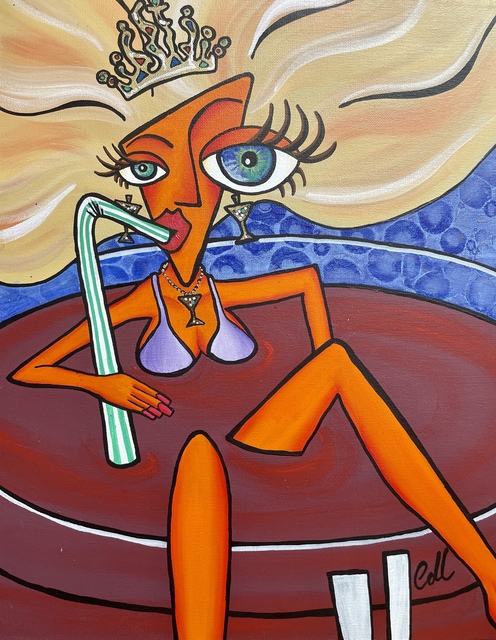Branding for Artists: Advice on Recognition and Amplifying Impact
Developing a solid brand for your art entails more than just designing a logo or launching a marketing campaign. It encompasses a range of considerations that extend beyond surface-level aesthetics.
By establishing a brand, you establish a connection between yourself and your artwork and validate your endorsement of a particular piece. This notion has become a central focus for many art galleries as they seek to attract consumers interested in specific art genres and styles.
By understanding a gallery's unique brand, consumers gain insights into the type of art they can expect to encounter when visiting.
Branding and Galleries
For instance, Aesthete Gallery (now permanently closed) in Hamilton was renowned for its high-end and estate art collection. Thornton Gallery, which is also no longer around, was recognised for its classic artworks, such as scenic paintings and decorative pieces, appealing to a middle-level audience. At the same time, Soul Gallery specialises in showcasing quirky and whimsical pieces.
For visual artists, creating a signature painting style is crucial in setting themselves apart from the crowd, such as my use of bold bright colours and my signature cartoon character the Boozehag. This distinct style can lead to increased sales, a loyal following, and even potential fame. Interestingly, many artists possess a signature style without consciously recognising it. The key lies in uncovering and utilising this unique style to attract sales and recognition.
Successful branding in the art world involves creating an easily identifiable product. Suppose an artist can discern the qualities that make their artwork unique and consistently incorporate them into each piece. In that case, viewers can recognise their work without relying on a signature. Collectors will be inclined to seek out more paintings because they know they can expect a consistent and distinctive artistic experience from the artist.
Well Known Artists and Branding
Examples of artists with solid branding through their painting styles include Claude Monet with his serene water lilies, Andy Warhol for his unique pop art and screenprint art, Pablo Picasso with his vibrant and abstract cubist works, Banksy with his captivating street art with its social messaging, Michael Smither with his striking scenic pieces and unconventional figures, Gordon Walters with his contemporary Maori designs, and Colin McCahon with his evocative writings integrated into his paintings.
What Can You Do?
Engaging in brainstorming sessions with friends and family can be a valuable exercise for gaining insights into your style or discovering a direction that might need to be noticed. The focus can be on something other than themes; it can also involve identifying unique colour combinations or painting techniques. For example, Vincent van Gogh's rough, quick strokes or Monet's use of bold colour "blobs" defined their respective artistic styles.
Artists may have distinct characteristics, such as using circular motions in their paintings or employing a meticulous approach with tiny brushes. The application of paint is often overlooked when an artist's subjects primarily define their signature style.
Additionally, opting for an unusual subject can capture the viewer's attention and leave a lasting impression, which is vital in creating a brand that not only sells paintings but also brings notoriety to the artist. Please do note, however, that creating controversial work has its drawbacks. You can read my other article on that here.
When curating art shows, I encourage artists to establish a cohesive theme that runs through their work and align their marketing efforts accordingly. While not all artists prefer to create a body of work centred around a single theme, having a solid brand helps bring unity and coherence to diverse pieces.
Imagine attending a show where each painting is so dissimilar that it's challenging to discern whether the same artist creates them. By employing consistent framing, similar sizes of artwork, and cohesive marketing materials, viewers can recognise that the collection belongs to a single artist. Of course, this approach may contribute to the framing or other elements becoming part of the artist's brand. Still, it aids in reinforcing the connection between the diverse pieces.
Your Brand
Your brand allows you to express your uniqueness. If you promote a generic brand without careful consideration, you risk diluting your brand identity. Both consumers and patrons seek individuality when associating with an artist. They want to connect with and understand the representation of your art, from your inner being to the gallery or event where your work is showcased.
For example, suppose an artist's brand revolves around portrait art but needs to explore and expand upon that theme. In that case, their work may become lost among numerous other portrait artists who lack uniqueness. Nothing distinctive will enable an art buyer to connect with that artist beyond the artwork itself. An example in my work is creating a unique character like my Boozehag aka Miss Chardonnay Minx, who achieved international success for her quirky difference and change from the norm.
However, an artist who consistently portrays portraits that challenge the boundaries between religious and cultural perspectives of the subjects would attract a specific audience intrigued by the art and the underlying issues raised.
Branding is vital because it allows your art, lifestyle, and passions to be displayed as a unified strategy. The key to creating a successful brand is to strike a balance and avoid narrowing your focus too much, which may limit your potential audience. A classic example of this would be an artist who primarily painted women with a religious theme but gradually shifted towards portraying them in an anti-female and frightening manner, resulting in unappealing artwork for most people.
While a narrow focus on your brand may attract a smaller group of interested individuals, consistency in your branding approach can expand your outreach and attract a broader audience. Ultimately, by staying true to your passion, you will touch the lives of more individuals who share those passions with you.
As you contemplate your artist brand, start by jotting down a list of the passions that drive your art, personal identity, and soul. Combine these with your beliefs and opinions. Then, craft the brand that best represents you and your art, allowing you to establish a unique presence in the art world.
What Is Branding?
Branding is a strategic process that involves creating a distinct identity and reputation for a product, service, or, in the case of artists, their artwork. It goes beyond visual elements like logos and encompasses a particular entity's overall perception, emotions, and experiences.
Branding involves shaping and communicating a unique story, values, and attributes that differentiate an artist or their work from others in the industry.
At its core, branding is about creating a solid and memorable impression in the minds of the audience, be it art collectors, gallery owners, or art enthusiasts. It is a way to establish a consistent and recognisable presence that sets an artist apart and helps them build a loyal following. A well-crafted brand allows artists to convey their artistic vision, style, and personality effectively to their target audience.
Successful branding in the arts involves understanding the unique qualities of an artist's work and translating them into a cohesive and compelling narrative. It requires artists to uncover what makes their art unique and consciously incorporate those distinctive elements into every piece they create. By consistently delivering a recognisable and exceptional artistic experience, artists can establish their own niche and attract collectors who appreciate their unique style.
It's More Than Just About The Art
Branding is not limited to the artwork itself; it also extends to the artist's public persona and how they engage with their audience. It involves effective marketing, positioning, and promotion of the artist's work through various channels, such as exhibitions, social media, websites, and collaborations. A strong brand helps create an emotional connection between the artist and their audience, fostering loyalty and trust.
Furthermore, branding enables artists to curate their work and exhibitions with a coherent theme or concept. This cohesiveness enhances the overall impact and resonance of their art, making it easier for viewers to understand and appreciate the artist's vision. By aligning their artistic expression with their brand, artists can create a unified strategy that reinforces their identity and attracts like-minded individuals who resonate with their message.
In Summary
Branding in the arts is the deliberate process of creating a distinctive identity, reputation, and emotional connection between an artist and their audience. It involves crafting a unique narrative, showcasing consistent artistic qualities, and effectively communicating the artist's vision and values. Through branding, artists can differentiate themselves, build a loyal following, and create a lasting impact within the art world.
If you found this article interesting, you might want to check out these other articles on art matters -
How to Make Money in Art - Bread and Butter Lines
Commissioned Artworks Made Easy - Insider Tips for Artists
Updated June 2024


